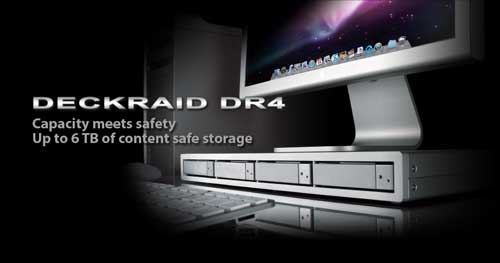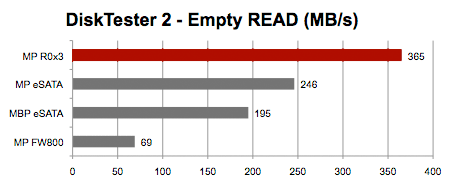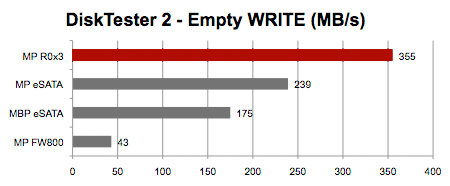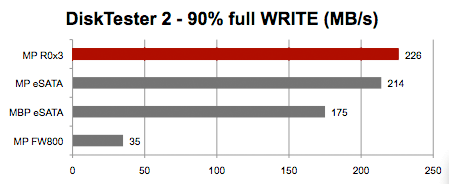RAID 5 STORAGE:
Stardom DECKRAID DR4
Posted Friday, July 10th, 2009, by rob-ART morgan, mad scientist.
Updated Monday, July 20th, 2009, with faster Seagate 7200.12 results.
There is a lot of interest in RAID 5 as a storage paradigm. The DECKRAID DR4 from Stardom not only presents an opportunity to show the speed difference from RAID 0, but to discuss the strengths and weaknesses of RAID 5 versus RAID 0.
The DECKRAID DR4 uses the Oxford 936QS chip to provide a quad interface. We tested it using its FireWire 800 and eSATA port. We tested using a MacBook Pro and Mac Pro.





EXPLANATION of GRAPHS
MP R0x3 = Mac Pro 2.93GHz Nehalem with Seritek/2eEN4 (containing 3 Seagate drives in RAID 0 mode) connected to Stardom 8X 4 port SATA 3G host adapter
MP eSATA = Mac Pro 2.93GHz Nehalem with DR4 (RAID 5) connected to Stardom 8X 4 port SATA 3G host adapter
MBP eSATA = MacBook Pro 3.06GHz with DR4 (RAID 5) connected to Sonnet Tempo SATA Pro ExpressCard/34
MP FW800 = Mac Pro 2.93GHz Nehalem with DR4 (RAID 5) connected to the built-in FireWire 800 port
(We also tested the FireWire 800 port on the iMac 3.06GHz and MacBook Pro 3.06GHz. They ran within a few ticks of the Mac Pro speeds.)
The DR4 had four Seagate Barracuda 7200.12 1TB drives installed
INSIGHTS
The Stardom DECKRAID DR4 (RAID 5) is a viable choice for expansion or backup storage. The RAID 5 mode is automatic and controlled in the box. Just install the empty, unformatted SATA drives. Power up. It builds the RAID 5 set and then will appear to Disk Utility as a single unformatted volume. Format it and off you go.
As you can see on the graphs, compared with the 3 drives in a RAID 0 mode, the DECKRAID DR4's 4 drives in RAID 5 mode run slower when empty but almost as fast when full. We compared with 3 drives because in RAID 5 mode, one-fourth of each drive is used for parity. In other words, the storage capacity of four drives in RAID 5 mode equals the storage capacity of three drives in RAID 0 model
The DR4, though, is designed for reliability and is fast enough for many applications. The overhead of the RAID 5 parity checks would imply that "green" 2TB drives from WD will transfer data just as fast as the fast 1TB drives we used. Though we have not tested it with 2TB drives, Stardom confirms they work fine.
If you run the DR4 connected to your Mac Pro in SATA mode, there is 4 port 8 lane SATA 3G host adapter available from Stardom. We used it for our testing. It has a Silicon Image based chipset that requires the Sil-3124 driver which is included on a CD. The card won't support booting OS X, but you can boot from the built-in FireWire 800 port.
We used it for our testing. It has a Silicon Image based chipset that requires the Sil-3124 driver which is included on a CD. The card won't support booting OS X, but you can boot from the built-in FireWire 800 port.
In the case of the MacBook Pro with the fastest SATA ExpressCard, you are limited to just over 200MB/s. So the fact that the DR4 maxes out around that speed means you have no downside with RAID 5 versus RAID 0.
RAID 5 -- NOT A PANACEA
The main strength of RAID 5 is the ability to tolerate the failure of one drive in the set. You replace the drive and it automatically rebuilds the set. Read more about RAID 5 on Wikipedia.
The weakness of RAID 5 is that when more than one drive fails in the set, your files are toast. Also, if the directory gets corrupted and software like DiskWarrior can't rebuild it, your files are toast. I contend that there is no substitute for regular backups using Time Machine or some other backup strategy. (The DR4 is Time Machine compatible.) If the DR4 is used for primary storage, then you may want two of them -- one for primary, one for backup.
For the maximum in transfer speed, RAID 0 is the way to go. However, it cannot recover from a hardware failure. That's why, again, you need a backup strategy.
WHERE TO BUY THE STARDOM DECKRAID DR4 and 4 Port SATA Host Adapter:
Order it from Other World Computing or TransIntl.com.